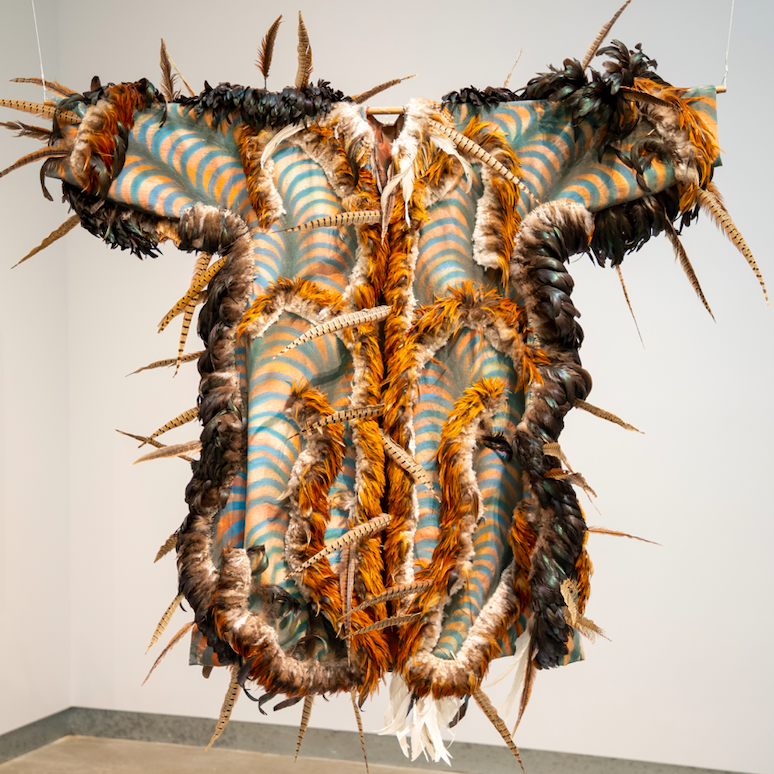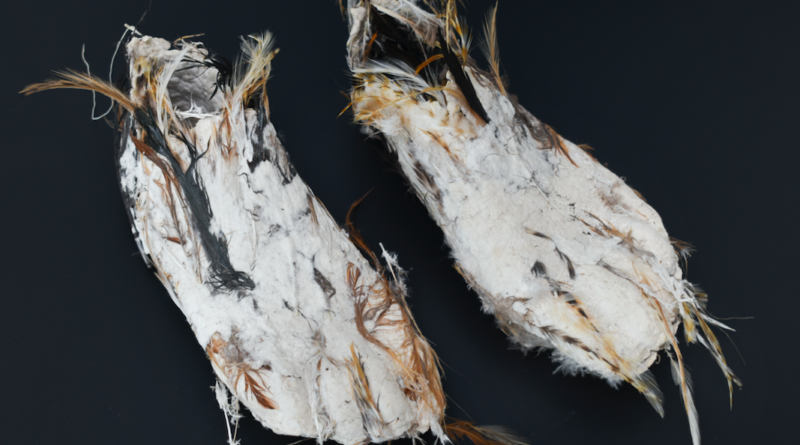INTERVIEW: Newark Museum celebrates Carlos Villa in new exhibition
Photo: Carlos Villa, Artist’s Feet, 1979‑1980. Paper pulp and feathers, two pieces; each approx. 5 x 15 x 7 in. (12.7 x 38.1 x 17.78 cm.) Lent from a private collection.
Carlos Villa was an artist who proved quite meaningful to the San Francisco art scene in the 20th century, but for many appreciators on the East Coast, his legacy is unknown. The Newark Museum of Art hopes to correct that lack of awareness with their recently opened exhibition, Carlos Villa: Worlds in Collision, presented in collaboration with The Asian Art Museum of San Francisco and the San Francisco Art Institute.
This career retrospective serves as the first East Coast exhibition of the prolific artist, who died in 2013 and is known for his paintings, drawings, sculptures, self-portraits and performance art, according to press notes. Specifically, he explored his Filipino American identity and culture, and championed the styles and mediums of non-Western art. Some of his pieces are religious in nature, reminding viewers of Roman Catholic vestments, while others are influenced by shamanic capes and the regal wear of Hawaiian nobility. Other pieces speak to his productive time in the post-war years of San Francisco and his entry in the highly influential Beat Generation, while the entire oeuvre showcases his enduring dedication to multiculturalism and his highlighting of communities often forgotten in the art landscape. In all, The Newark Museum of Art is displaying 36 works by Villa through May 8.
Tricia Laughlin Bloom is curator of American Art at The Newark Museum of Art, and she said the exhibition has been in the works for years, with some delays due to the COVID-19 pandemic. “This show was created, first of all, to celebrate Carlos Villa in San Francisco,” Laughlin Bloom said in a recent phone interview, “but then also with the idea that it could be a traveling exhibition.”
The Newark Museum of Art was specifically approached because of the institution’s Oceanic collection, which has remarkable works by artists from the Asia-Pacific region. The histories and styles imbued in these works were of great interest to Villa, serving as inspiration for his own artwork, and the curatorial team was interested in seeing any connections across the generations.
“That’s what started the conversation,” Laughlin Bloom said. “Carlos Villa is a Filipino American. Carlos Villa is also an American, but Carlos Villa is also looking at these objects from so-called faraway places. And museums are places where you can learn more about the South Pacific, for example, and we have these collections that we don’t always get out. So it ended up being a great way to activate our permanent collection.”
The initial idea was for Carlos Villa: Worlds in Collision to launch in San Francisco, and then the show would travel to Newark, New Jersey. However, the first wave of COVID-related closures presented some pauses and slowdowns. At one point, the curatorial team was unable to even visit the museums that would host these objects, so San Francisco had to indefinitely delay the exhibition. This opened up an opportunity for Newark to premiere Worlds in Collision.
“First of all, this is an artist who is really under-exposed on the East Coast, so we’re really proud to have the chance to showcase someone who is a really major figure in the multicultural movement and a really important figure in San Francisco,” Laughlin Bloom said. “We’re really getting to introduce him for the first time to East Coast audiences, for the most part — everything has a caveat. That brought another level of collaboration because we’re putting the show together at the same time that they’re putting the show together. It’s going to be slightly different out there, but we really have worked very closely with the whole team in San Francisco to get the checklist determined and figure out the best way to bring it all together in Newark.”
Laughlin Bloom said she finds the Villa pieces “visually stunning” and “captivating.” The works should fascinate visitors, even if they have never heard of Villa or are unaware of his overall creative mission. Essentially, he was creating a Filipino American art history for modern-day audiences, showing people the roots of his cultural heritage through contemporary art that feels as if it’s from another time period.
“You’ll learn all that by learning about him and coming to the show, but even if you don’t have that level of interest, just on a visual level, these really extravagant capes and body casts and objects that look like they have some kind of ritual use, I think are going to be really captivating for people,” she said. “In that sense, we’re showing some really stunning, groundbreaking contemporary art, and then as the title suggests, Worlds in Collision, he was also an important activist and mentor and professor advocating for giving non-Western artists and cultures representation in contemporary art. So this idea of worlds and collision, no one is just from one place. A lot of it is about the immigrant experience. It’s his immigrant experience, but again even if you’re not Filipino American, you’re not yourself a direct first-generation immigrant, those stories are highlighted in a direct way by the art. I always like art that works on both levels, purely visual, you don’t need any background, you don’t need to know who he is, but then the stories contain the connections across cultures and across generations that are so valuable, that only artists can come up with it seems.”
One work is called “Ritual,” a large mixed media on unstretched canvas that looks like spools of yarn worming their way around a claustrophobic square. There’s a solitary knot at its center that hangs amidst the colors of the intestinal chutes and ladders that dominate the piece. “Orange-a-Boom,” a work from 2010, is an opened wooden panel painted orange, with scored lines stretching the full 72 inches of the piece’s height.
These objects will likely keep visitors entranced for some time, and adding to their experience are planned events that celebrate Villa’s Filipino American heritage. For example, on March 26, the museum is planning a We Be Bayan community day with opportunities to contribute to an oral history project. Mabuhay Guro, a multimedia presentation highlighting other Filipinx artists, will be presented April 21.
“In San Francisco, he was really a part of the Beat Generation, so cross-disciplinary, not just visual art, but poetry and performance,” Laughlin Bloom said. “All of those things definitely influenced him. He had a really interesting period of time that he spent in New York in the late ‘60s when he was working in a more abstract and minimal way before he pivots to this work that is very personal and … these works that look like they’re from another culture. He looks to Indigenous people of Australia and ceremonial capes from Hawaii, and he really looked broadly not just at the Philippines, but all over, to say what’s left out.”
She added: “Yes, you can see that San Francisco moment in his work, but then he forged an original path. When we were first starting to talk about this show, colleagues at the museum said, ‘Well, who is he like? Who would you put him with in that time period?’ There’s a wonderful group of artists in San Francisco that he was a part of, but I think in terms of the activism contained in his work and the way that he put his body into his work, somebody like David Hammons … an African American artist — very much in making constructed objects, body prints and objects that are not your typical materials you would expect to find in contemporary art — is a good comparison. In some ways, it’s hard to find a direct comparison with his work because it’s so original.”
By John Soltes / Publisher / John@HollywoodSoapbox.com
The Newark Museum of Art presents Carlos Villa: Worlds in Collision through May 8. Click here for more information and tickets.


